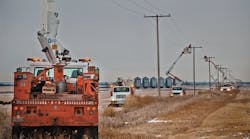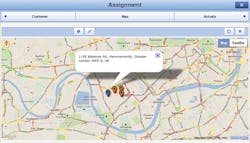Linemen once wrangled with paper maps and received work assignments through their cell phones or radios. To improve the efficiency of their field workforce, however, more electric utilities are arming their linemen with ruggedized laptop computers, smart phones and tablets to expedite record keeping and streamline dispatching.
For example, SaskPower, a utility in Saskachewan, Canada, equips all of its work trucks with ruggedized computers loaded with mobile workforce management software. Using this technology, the linemen can not only view the location and details for each asset in the system, but they can also review and complete work orders out in the field.
SaskPower turned to mobile computing in 2009, when the utility began working with SAP Software Solutions, DiabSolut and ClickSoftware. Every district operator, foreman and journeyman has his or her own touch-screen Panasonic Toughbook laptop computer equipped with Windows 7. Because the field workforce works in rugged environments and in extreme temperatures, SaskPower invested in laptops with rubberized corners, water-resistant covers, a snap-lock cover on the USB port and a durable screen.
Workers mount their laptop computers in the passenger seat of their trucks. Once they plug the laptops in, the power is engaged, the Internet feed becomes live and the GPS is enabled. The field employees are then ready to start their work day, handle trouble calls and maintain SaskPower’s system.
Training Linemen
Before rolling out the scheduling and work management program to the field, SaskPower first beta tested the software. SaskPower used three districts: the city of Saskatoon, the rural area east of the city and the rural area west of the city. The city district operators participated in a pilot project and worked out any glitches before the software was rolled out to the field.
Next, the field workers attended a multi-day training session to learn a program called Map Frame. As part of the training, they used the program out in the field when patrolling and practiced entering data in all the forms. The utility’s IT department answered questions for linemen when it came to designing maps for as-builts. In addition, the workers from different districts helped one another, shared their experience with different programs and provided tips on how to use the program.
Mapping Work Routes
One of the key reasons why SaskPower invested in the mobile software was to increase the productivity of its field workforce. In the past, district operating supervisors would use a computer program to pull up priority work, print off notifications, manually sort them out and then make a planned route for the work crews to eliminate any back-tracking. The district operators and journeymen would then drive to the service center, where the supervisors would hand them their work assignments for the day. When they installed a meter, they would write down the numbers on a slip of paper, which they would later hand to the customer service department to input into the system.
Through their shift to mobile computing, SaskPower streamlined the paper-based, labor-intensive method to save their workers travel time and improve the accuracy of the data-entry process. Now that the field workforce has computers equipped with a mobile workforce management software program, they can leave their homes at 8 a.m., and they no longer need to go to the office. Instead, dispatch sends them their assignments directly to their homes, and they can send their reports directly from the field to customer service, which saves both time and effort for the linemen and the office employees.
One of the significant advantages of the Optimizer scheduling program is that it organizes their workload into a well-planned route. For example, linemen are sent either a task list of short-term work that takes 15 to 20 minutes each, or they are expected to work on “day work,” which can span an entire work day. Then, as the linemen slowly work through their tasks, the program brings them back home at the end of each work day.
One of the biggest selling points for the employees was that instead of leaving home at 7:20 a.m. to drive to the service center, they now can leave their homes at 8 a.m., giving them more time with their families in the morning. Also, they can arrive back at their homes by 5 p.m., rather than leaving the service center at that time.
Of course, like any change in work methods, the alteration in the workers’ schedules and daily routine also has a down side. Namely, they no longer meet at the service center each morning to talk about what happened the day before, review abnormalities in the system, have a morning tailboard and then head out on their way. As a result, the crew members don’t see each other as often, and if none of their assignments take them back to the service center, then they may not see any of their coworkers during the work day. To solve this problem, many of the linemen often meet up with one another if they’re working in the same area, which improves camaraderie and safety.
Scheduling Work
Five or six years ago, the field workforce primarily used Panasonic Toughbooks as a data-capture tool. Now, they can rely on the internal GPS and mapping tools to trace out the line as the workers are driving down the grid road.
About two years ago, the company started using a program called Workforce Scheduling and Optimization from ClickSoftware, which currently works with more than 75 utilities throughout North America.
If the workers are called out in the middle of the night, they can get into their truck, power up their computers, and simply tap on the asset or affected location to get driving directions. Some of the district operators now have the new CF31 Toughbook laptops, which include even more shortcuts and user-friendly options, which is helpful during middle-of-the-night trouble calls.
Called MapFrame, the program has helped the field workers navigate the rural settings in the district, especially those that are new to the company and aren’t familiar with the
service territory. Rather than trying to find the location with a paper map, the workers simply type in a location, click on the route and then get directions just like a traditional GPS in a car.
The mapping program also includes some othe helpful tools. For example, the technicians can pull up transformer codes, and the program will tell them the feeder circuits they are dealing with without having to scroll through maps to trace back to the origin and the line. Also, if they are doing a patrol in a rural setting, they can enter all of their data to upgrade the map with new information. Therefore, the mapping program also becomes a valuable data-collection tool.
The technicians can use a program called Snag It or General Electric Digital Energy’s Field Smart to modify maps by pulling in text, drawing circles around assets, or adding arrows to make an as-built drawing for the field workforce to use when maintaining their system.
Maintaining Assets
Workers also can use the mobile software to find equipment within the service territory and to obtain information about certain assets. For example, if they need to work on a transformer bank, they can right click on the asset and open it up in the mobile software to quickly learn its serial number, voltage and size. If they need to repair a pole, they can click on the asset within the software program, and a pole tag number will immediately pop up on the screen.
Workers no longer need to drive to a pole and climb it to view the data on the assets. With the mobile software and GPS, the process that used to take hours now only takes minutes. Then when they get done working on the asset, they simply click a button to indicate that the job has been completed.
Protecting the Field Workforce
The mobile computing software and ruggedized computers help to improve the linemen’s productivity as well as their safety in the field. The program has a working alone timer, that automatically sets for two hours. Workers in the city do not have a lot of trouble with cell phone and radio service, but those working in the utility’s two rural districts can turn to this added protection. If they aren’t back in their work truck within two hours to turn off the timer, then it notifies SaskPower’s dispatch that something is wrong and help is needed. Workers can also hit a panic button if they are in an emergency situation and require immediate assistance. This feature can save a lineman’s life, especially if he or she is working in a remote area of the service territory. When a user touches this large button on the bottom right of the ClickSoftware screen, dispatch is notified.
By having the capability to protect its field workforce and enhance workers’ productivity, SaskPower has been able to fully harness the power of mobile computing technology.
David Breeze ([email protected]) is a district operator for SaskPower in Saskatoon, Saskatchewan, Canada. He has been with the company for nine years and is responsible for maintaining the company’s distribution in the city, working on preventive maintenance and handling trouble calls. He also installs meters, resolves customer disputes and performs site checks for construction.
Companies mentioned:
ClickSoftware | www.clicksoftware.com
DiabSolut | www.diabsolut.com
Mobile Frame | www.mobileframe.com
SAP Software Solutions | www.sap.com
SaskPower | www.saskpower.com




